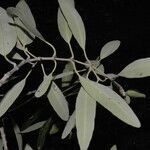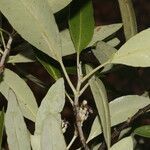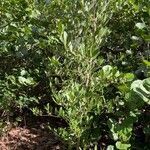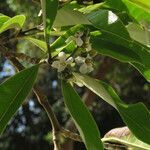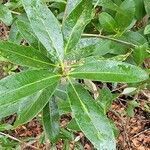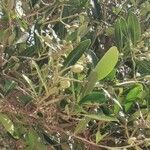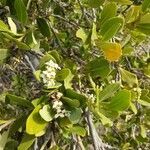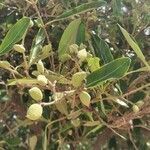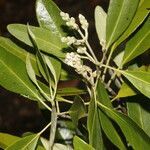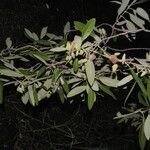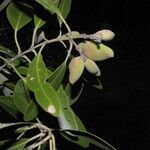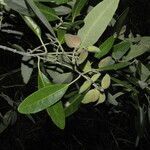normally exceeding them in height; trunk short, to 50 cm in diameter; bole crooked, sometimes to 40 cm diameter at breast height; roots deep-seated; pneu-matophores many, small, erect, about as thick as a pencil, projecting 5-10 cm above the water, leafless; stilt-roots absent; bark from black or dark-brown to dark reddish-brown or gray, yellow when scraped, smoothish, sparsely longitudinally cracked or shallowly fissured and rather scaly; branches spreading, crooked; branchlets and twigs slender, often more or less articulate, brownish, more or less tetragonal, often obscurely margined at the angles, glabrous or minutely grayish-tomentellous, often shiny, sparsely lenticellate with scattered corky len-ticels; nodes swollen, distinctly annulate. Leaves with the blades firmly char-taceous or subcoriaceous, varying from gray-or bright-green to rich-or dark-green and shiny above, usually pale or gray-silvery beneath, occasionally brunnescent or nigrescent on both surfaces in drying, lanceolate or lanceolate-oblong to oblong, elliptic, or obovate, 4.5-15 cm long and 1.8-4.4 cm wide, entire, acute to blunt or obtuse apically, acute or acuminate to cuneate basally, glabrous but densely impressed-punctulate above, varying from uniformly and densely whitish-or grayish-furfuraceous or tomentellous (with closely appressed furf) to glabrous and more or less punctate beneath, the furf apparently deciduous in patches in some forms; petioles slender, 2-27 mm long, flattened and canaliculate above, convex beneath, mealy or glabrous, often wrinkled in drying. Inflorescences axillary and terminal, spicate or subcapitate, the spikes 1.5-6.5 cm long and 1-1.5 cm wide during anthesis, the axillary spikes usually confined to 1 pair at the base of the terminal and shorter than it or another pair in the next lower axjl, dense. Flowers usually opposite, 1-15 pairs per spike, sessile, sometimes few and distant or close and decussate or densely glomerate-crowded, small, irregular, 1-2 cm wide during anthesis, fragrant, highly nectariferous; bractlets and prophylla light-green, ovate or oblong, sessile, closely appressed to the calyx, obtuse or acute apically, densely sericeous-pubescent; calyx light-green, the lobes ovate, 3-5 mm long and 2-3 mm wide, densely appressed-pubescent outside, glabrous within, in fruit enlarged but not at all incrassate or indurated, 5-parted practically to the base, ca. 9 mm wide, each lobe ovate-lanceolate, ca. 4 mm long and 2 mm wide, acute, densely appressed canescent-strigose outside, glabrous and shiny within; corolla campanulate, yellow or cream to white, apparently yellow when first opening, later turning white, sometimes white with a yellow throat or cream with an orange throat, occasionally creamy on the lobes and brown below, 12-20 mm long and ca. 10 mm wide, parted to about the middle, the tube equaling or shorter than the calyx, practically glabrous, the lobes spreading, unequal, 2-2.5 mm long, oblong or subquadrate, rounded apically, densely cinereous-pubescent outside, velutinous-tomentose within, finally so completely reflexed as to touch the corolla-tube; stamens slightly exserted from the corolla-tube, included by the lobes, finally blackish and conspicuous when the lobes become completely reflexed; style as long as the stamens; stigma bilobed. Fruit oblong or elliptic to more or less obpyriform and asymmetric, 1.2-5 cm long and 7-13 mm wide, often turning almost plum-color when exposed to the sun, apiculate apically when young, densely whitish-tomentellous throughout, often also more or less white-strigose, especially apically and on the apiculation.
More
A shrub or tree. It grows 20 m tall. The trunk is grey and the bark can be cracked. It has thin pneumatophores or breathing roots. They can be 30 cm long. The leaves are simple, opposite and narrow. They are 10 cm long and 3 cm wide. They are a lighter colour underneath. Salt crystals form underneath the leaf. The flowers are small and have 4 lobes. They are tube shaped and 1 cm across. They have a fragrant honey smell. The fruit is flat and green. It has one unequal sides seed. It is 2 cm wide and has a pointed end.
Erect or spreading low shrubs or handsome and symmetric slender trees, 12-14 (-25) m high, sometimes bushy, usually intermixed with other mangroves but
